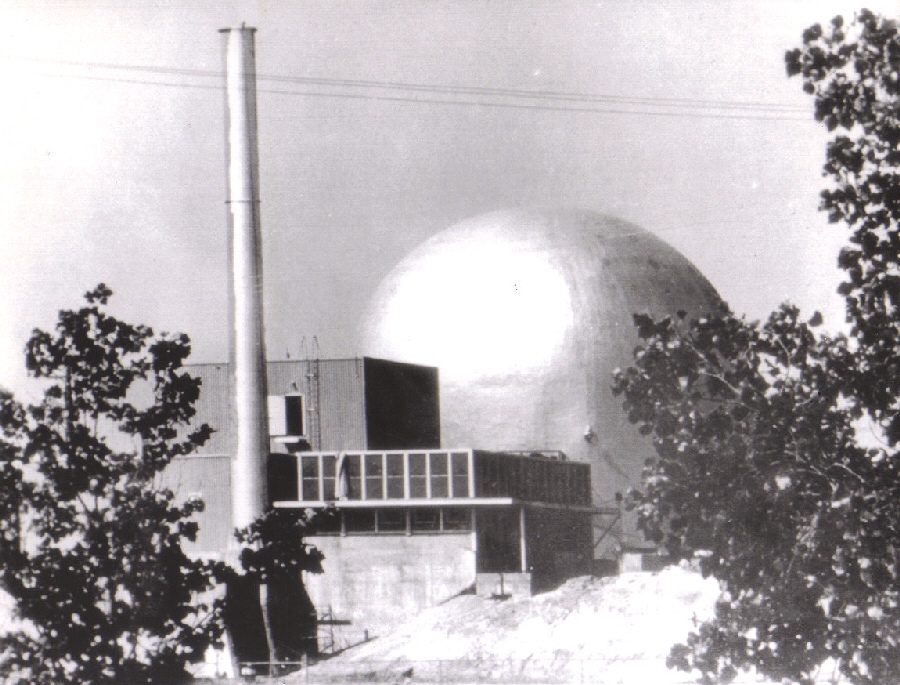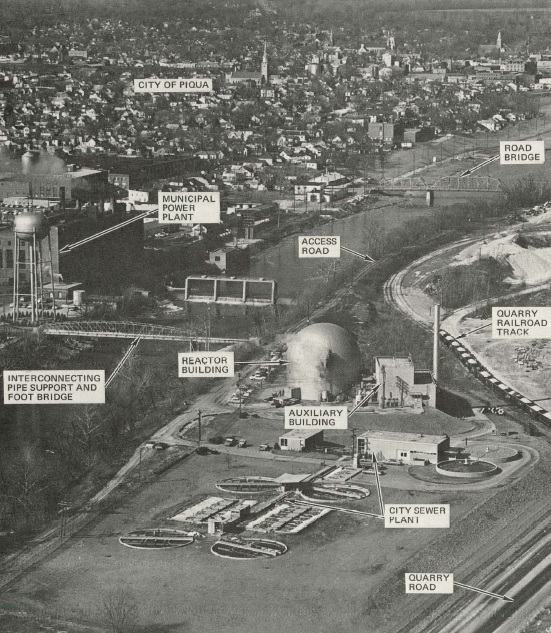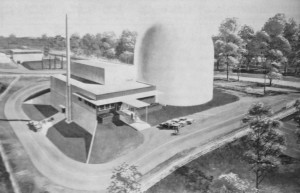Piqua organic-cooled reactor in photo and film

Illustration from Will Davis library courtesy US AEC.
This week's (thinly veiled and early) Matinee feature, augmented by my rambling and some illustrations from my library, is a short AEC film made to describe and explain the long-since-shut-down Piqua Nuclear Power Facility, in Piqua, Ohio.
The early atomic era's quest for economic nuclear power saw organic coolant - that is to say, chains of hydrocarbons - come briefly to the forefront for a variety of reasons. Some of those are:
•Organic coolants did not require the primary system to be highly pressurized. This led to orders of magnitude less potential energy release in case of a primary leak or rupture, shrinking and in theory potentially eliminating vapor barrier containment as previously known.
•Because of the noncorrosive and low pressure characteristics inherent in conceptual organically cooled reactor systems, it was possible to manufacture primary coolant systems more to the standard of petrochemical plants than to the then-standard for nuclear plants, saving a great deal of cost.
•Organically cooled nuclear plants were able to achieve superheat to a significant degree, unlike existing light water cooled plants. Attempts to produce superheat in water cooled plants at Pathfinder and BONUS essentially failed, leaving organic coolant well ahead in the low cost reactor field in terms of steam condition compatibility with existing steam plants. This was taken advantage of at Piqua where the reactor supplied superheated steam to an existing municipal plant.

Illustration from Will Davis library courtesy Atomics International.
The new "hook on" facility at Piqua was also set up to operate as a load follower, and demonstrated an ability to follow load on the local grid quite well. The primary plant was set up to provide full primary coolant flow to the superheaters at all times but then could variably bypass the steam generator portion of the system to change steam production depending on the load demand signal.
The coolant selected for these plants, a terphenyl mix available either under the trade name Dowtherm (from Dow Chemical) or Santowax (from Monsanto) had a couple of drawbacks, however. It was subject to breakdown - pyrolitic decomposition, which necessitated keeping hot leg temperatures below 700F (preferably below 600F) and radiolytic decomposition which latter could not be avoided. It was discovered that this plant could, by feed and bleed method inserting about 60 lbs. of new coolant per day, be maintained at a high enough percentage of non-degraded coolant for acceptable operation. As mentioned in the film, the separated (degraded) coolant was allowed to decay and then burned. This waste burning could be used to heat up the plant on a startup although the normal method was to supply steam from the original coal fired Piqua Municipal Power Plant back to the new reactor facility.
The cracking of the coolant and subsequent polymerization of the broken chains led to a series of obstructions in the core, the last occurring in the form of a large toroidal shape around the core. Although the contractors had cleaned out the core and developed a plan to prevent this from happening again, the Atomic Energy Commission decided to stop funding organic cooled plants before the end of the 1960's and the decision was made by the city of Piqua not to purchase, but instead to decommission, the reactor.
Given the ability to construct a facility such as this right in a populated area and the ability to hook on to an existing power plant and provide that plant with superheated steam, it seems only a matter of time before someone, somewhere revisits the organic cooled concept - a concept tested at NRTS Idaho and operated commercially for years right in the heart of Ohio.
Now - get ready to go back in time to Piqua! Enjoy the film!
 Will Davis is a member of the Board of Directors for the N/S Savannah Association, Inc. He has been a contributing author for Fuel Cycle Week, and he used to write his own popular blog Atomic Power Review. Davis is also a consultant and writer for the American Nuclear Society, and serves on the ANS Communications Committee and the Book Publishing Committee. He is a former U.S. Navy reactor operator and served on SSBN-641, USS Simon Bolivar. His popular Twitter account, @atomicnews is mostly devoted to nuclear energy.
Will Davis is a member of the Board of Directors for the N/S Savannah Association, Inc. He has been a contributing author for Fuel Cycle Week, and he used to write his own popular blog Atomic Power Review. Davis is also a consultant and writer for the American Nuclear Society, and serves on the ANS Communications Committee and the Book Publishing Committee. He is a former U.S. Navy reactor operator and served on SSBN-641, USS Simon Bolivar. His popular Twitter account, @atomicnews is mostly devoted to nuclear energy.


